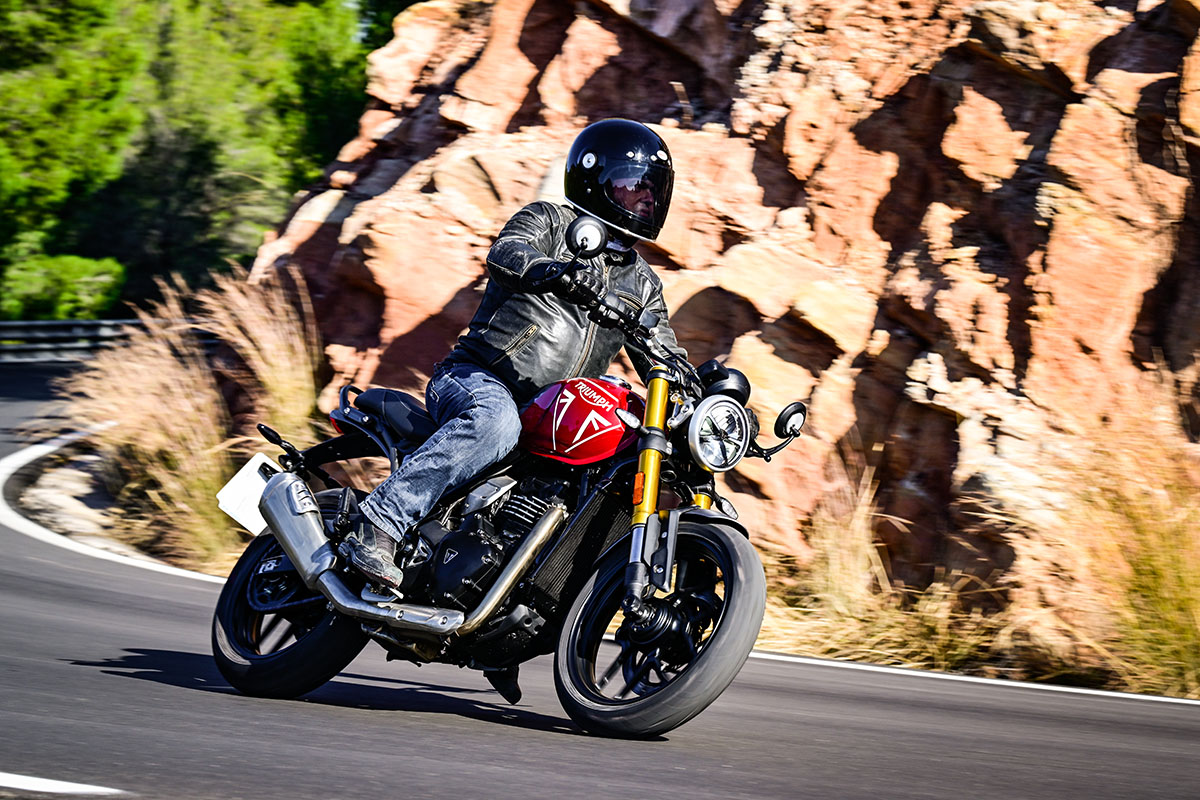In a world where we lust over 200bhp adventure bikes and machines laden with cutting edge electronics packages, it’s easy to dismiss the new Triumph Speed 400 as basic and irrelevant, however the genuinely all-new single is one of the most significant models to come from the British company. Ever.
While Europe and the US buyers are still largely focussed on big capacity motorcycles, there’s a huge demand for smaller, sub-500cc, bikes in India and other developing Asian markets. With millions of potential sales on the table, these really are very important motorcycles for the Leicestershire based company, helping it to attract new people to the brand and massively increase its sales as a result.
The Speed 400, and the related Scrambler 400 X, are not Triumph’s first attempt at making a small capacity motorcycle with which to take on these massive Asian markets. It’s a decade since the company abandoned plans to take on the immense undertaking of building a basic 250 for sale in India, despite some pretty near to production prototypes being spied testing, and now they have followed European competitors in linking up with an Indian automotive giant to develop and build a new model.
While BMW have joined forces with TVS, Triumph have followed in the tyre tracks of KTM by partnering with Bajaj to bring its new 400s to market. This is significant. Triumph is a major player in the European motorcycle industry, selling just over 75,000 units in its last financial year. That’s more than Triumph have ever sold in its 122-year history, but still small fry in the overall global market. Despite most British bikers having never heard of them, Bajaj was reported to have sold more than 3.4 million bikes in 2023. When it comes to making, distributing and selling bikes for the Indian market, they know their stuff. Triumph says it has three factories geared up to assemble the new models, with existing plants in Thailand and Brazil combining with a brand new facility in India to give a capacity to build 5,000 of the new 400s a month initially – with a potential capacity of almost a quarter of a million bikes a year possible. If successful, these two bikes have the ability to change Triumph’s business forever.
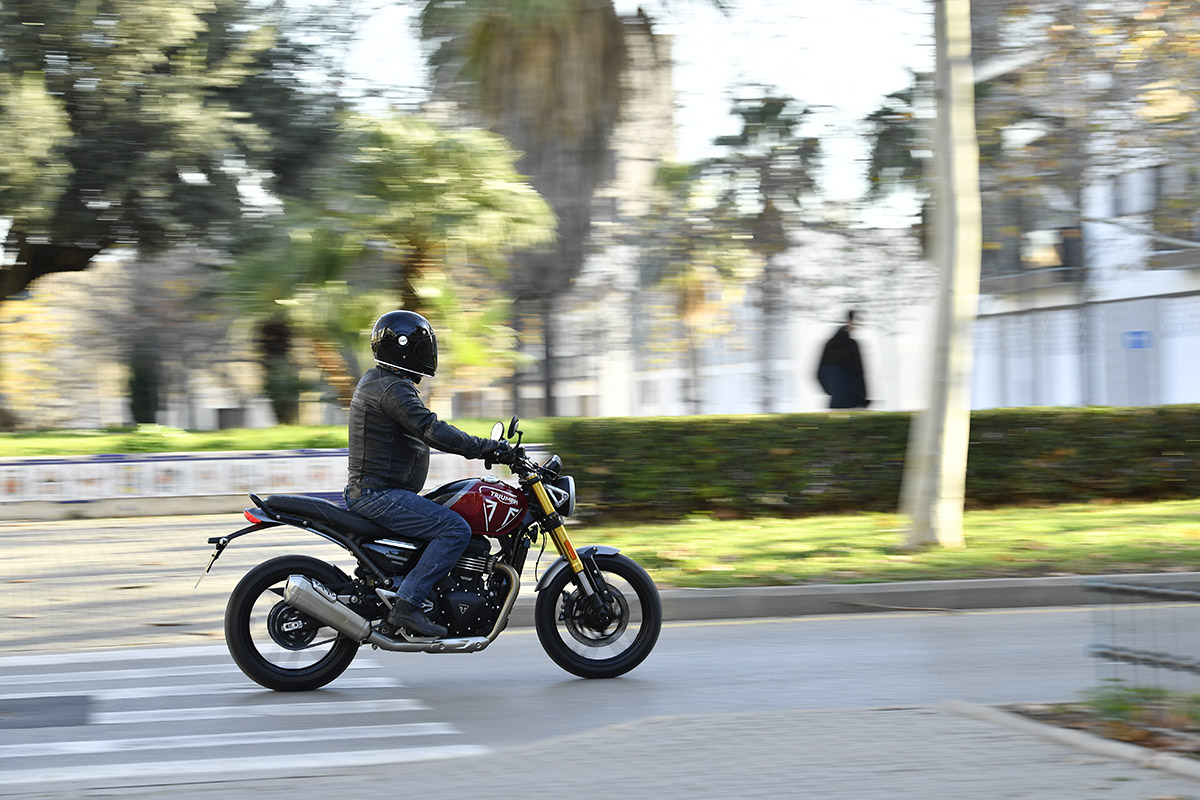
So on to the Speed 400
This huge Asian opportunity makes it easy to understand why Triumph’s new TE series platform is so important to the growth of the company, but it’s not just a bike for ‘over there’. The arrival of pan-European A2 licence laws has seen a new market open up closer to home in recent years, with sales of Honda’s 500s and Royal Enfield’s burgeoning range demonstrating that there’s a strong market for small and inexpensive bikes here on the British Isles too.
And Triumph’s first single in over five decades is not simply a rebadged Bajaj, but an entirely new design developed from the ground up by Triumph in Leicestershire. The engine is a thoroughly modern single cylinder unit, liquid cooled, with four-valves and delivering just under 40bhp. That’s a bit below the 47bhp allowed under A2 licence regulations, with Triumph saying it built a single not only because it is cheaper to produce, but also because the single cylinder firing pulses give it more character. A win-win they say.
To ride, the Speed 400 is straightforward but fun as well. Often when we ride budget bikes, we’ll come back and say something like ‘it’s a great little bike but I would change the tyres’ or ‘it handles great but the shock lets it down’. Triumph, however, have really gone to town with their 400s and the level of detailing and engineering is a step above anything in the class. The level of components and the attention are the first things to hit you when you see the bike in the metal.
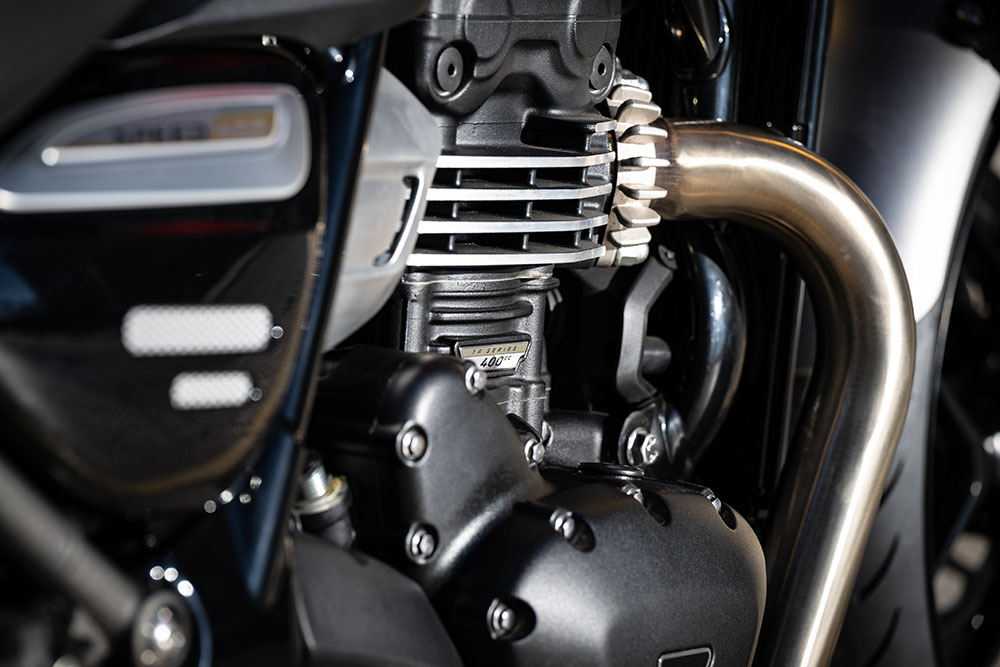
Hidden away inside the engine is some really clever stuff too, with lots of high end engineering going on. The single balancer shaft contributes to as characterful feel as you’ll find on a Euro5 bike, and there’s a lot of stuff hidden in there that makes it all super efficient. Things like diamond like coating on some of the internals are not really that important to the average rider, but contribute to an engine which can deliver a claimed 80mpg and which only needs servicing every 10,000 miles. For comparison, Royal Enfield’s 350cc singles have servicing intervals of 3,000 miles, or every six months.
Triumph says that the 400s have been built to get new customers into the brand, whether that’s younger Europeans or customers in emerging markets like Brazil and India for whom a bigger capacity machine would be out of reach. They’ve deliberately made it a ‘proper’ Triumph, with all the same quality and attention to detail for which their bigger models are renowned. Some of the engineering touches confirms this. There’s very little exposed wiring or cabling, the radiator is neat and bulky items like cat boxes and coolant tanks are packaged out of the way. This is something Ducati and Triumphs always impress me with, and I am pleasantly surprised to see the Speed 400 integrate this high level of engineering. Little touches like the machined fins and badging on the cylinder are really, really classy.
And for all the chassis too has been built to a price, they’ve not cut too many corners. The single front disc gives away the modest performance of the Speed 400 but the radially mounted ByBre calipers work exceptionally well.
It comes shod with Metzeler Sportec M9RR tyres, which frankly are way beyond what I would have expected on a bike of this price and power output. In my mind, it’s a real statement of intent from Triumph and definitely to be applauded. Rightly or wrongly, I tend to judge manufacturers on the tyres they choose as original equipment on their motorcycles. Cheaper tyres would have been expected (and surely have been more profitable for the company) on the 400 but rubber’s always the key factor in determining how enjoyable and confidence inspiring a bike is, and these Metzelers are of the specification you’d find on bigger and more powerful machines. They work very well, and show how Triumph want the Speed 400 to continue their legacy for building good handling motorcycles.
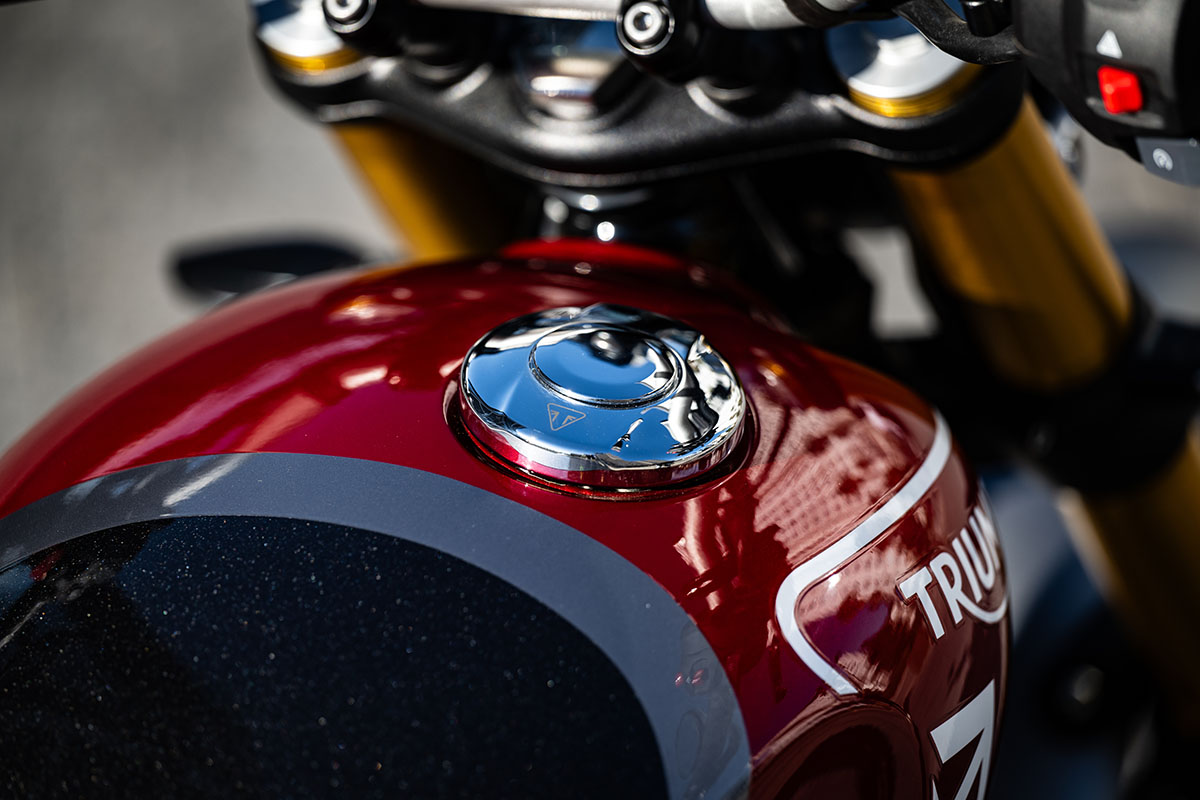
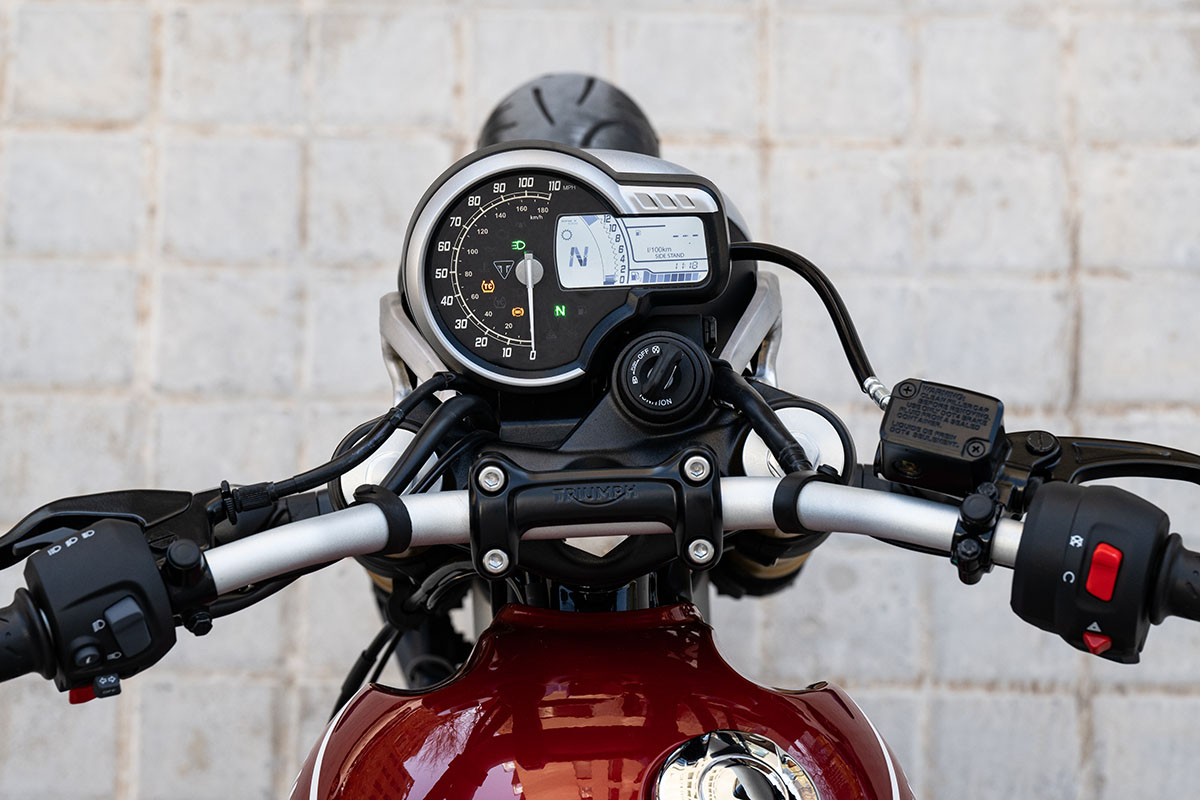
And it’s the componentry which makes the Triumph stand out in the class. From the aluminium handlebars, through to the traditional saddle, flip cup Monza style filler cap and gold coloured 43mm Showa big piston forks. The only adjustability on the suspension comes at the rear, where the gas pressurised monoshock can be adjusted for preload, but it felt fine for my needs, even when pushing on through mountain roads. For the record, I weigh 80kg and am a mere 165cm.
There is a genuine family resemblance between the Speed 400 and the bigger 900 and 1200cc twins, which gives it an added degree of street cred. The bar end mirrors, for example, are another area where the spec exceeds expectation. They work well too, even though the glass area is small, being well positioned and giving a good view of the road behind.
Three colours are available at launch: Phantom Black, Carnival Red and Caspian Blue. All utilising Triumph’s large triangular logo as a design element and have a black metal flake contrast. It’s the quality of paint you’d expect on a bigger and more expensive model from the Triumph range. It’s a bike to be ridden with pride.
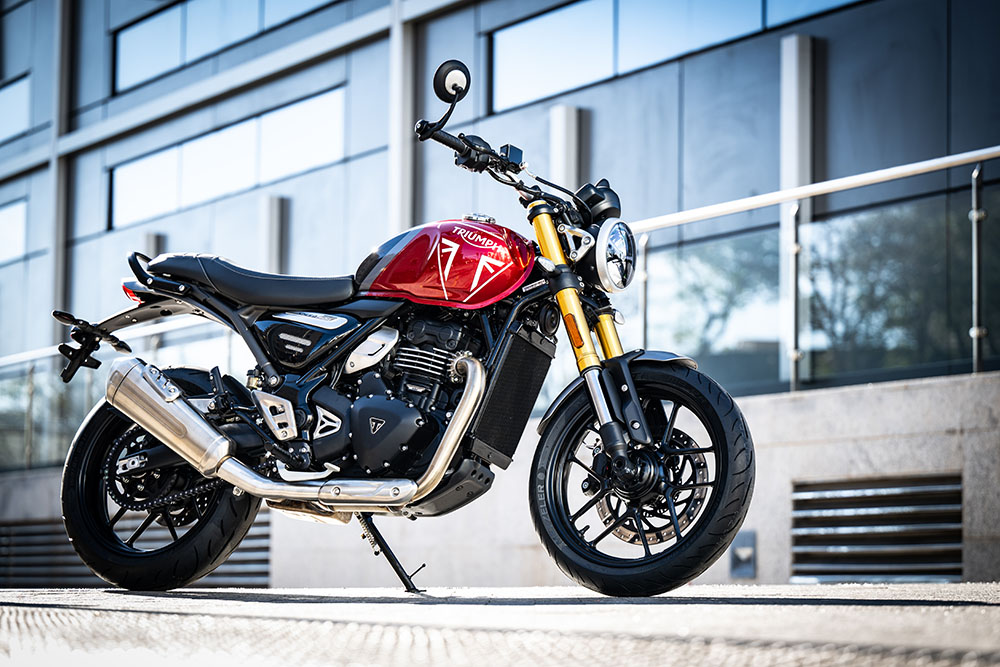
Triumph Speed 400 competitors
The Triumph Speed 400 goes into a competitive A2 licence sector, which includes a diverse bunch of models from some top manufacturers.
On paper, BMW’s G 310 R is one of the most obvious rivals, although the Triumph undercuts the German manufacturer by £200 while offering more performance. Husqvarna’s recently updated Vitpilen 401is another single combining retro looks with thoroughly modern tech, offering class leading tech and performance albeit at a premium – coming with a £5,599 price tag.
There are plenty of more contemporary styled two-cylinder A2 bikes on the market, but none can match the Triumph’s sharp RRP. Yamaha’s MT-03 (£6,105), Honda’s CB500F (£6,099) and the new-for-2024 Kawasaki Z500 (£5,699) all deliver a little more performance but can’t match the Triumph’s timeless retro lines or sub-£5k price tag.
If performance isn’t such an issue, Royal Enfield’s HNTR 350 delivers classic Brit bike vibes on a budget. The Indian manufacturer’s offering may only have half the horsepower of the more modern Triumph design, but it looks great and costs over £1,000 less than the Speed 400 – although the additional servicing requirements may quickly eat into that for higher mileage riders.
What Triumph appear to have done is to carve out a real niche in this sector, coming in with a machine sitting between the basic stuff like the Enfields and the sportiest offerings from KTM and Kawasaki. It’s a clever play, helped by the brand’s history and credibility of delivering modern classic machines.
What’s the Triumph Speed 400 like to ride?
We were fortunate enough to ride the 2024 Triumph Speed 400 at the global press riding launch, which took place in Valencia, Spain.
The sunny weather and warm temperatures gave us an opportunity to try out the machine around the snarled up city streets, as well as on the surrounding mountain roads.
With a 790mm seat height and weighing just 170kg fuelled up and ready to go, the Speed 400 is easy to mount and paddle around on. It’s aimed at inexperienced riders, and really is very unintimidating – with the single cylinder design creating a narrow saddle which makes it easy for us shorter riders to get on with.
The suspension is compliant and well damped. I found it spot on and hard to fault, even on the few rougher pieces of road we experienced during our 100 mile test ride. The good thing about being on these press events is that you are able to share experiences with other journalists, and even the bigger and heavier guys seemed impressed.
After a full day in the saddle I came back still feeling fresh and like I could do it all again, which is full credit to the seat comfort, suspension and ergonomics – although I would add not everyone was as complementary about the saddle.
Our ride took in a lot of mountain passes in the hills surrounding Valencia, where the light weight and agility of the Triumph shone through. What was also impressive was the motor, which is impeccably fuelled and incredibly flexible. Ridden enthusiastically, the endless hairpins revelled in running up and down the slick gearbox but, in reality, the bike was just as happy to be ridden lazily. Stick to third or fourth gear and the Speed was in its element, with the torque digging it out of slow corners without a hint of bogging down.
On the open roads it is so much fun. As an experienced rider, it’s always really satisfying to thrash around on a small capacity bike, being able to extract so much more of the performance than you would reasonably do on even a 60 or 70bhp bike.
Being a little critical, the engine does get a bit buzzy at high rpm, but that’s more a trait of small capacity machines in general as it is this one in particular. Compared to most other machines of this capacity I’ve ridden, it’s as smooth as butter but if you are thinking of downsizing to the 400 it is worth considering.
Triumph are a bit cagey about the Speed 400’s top speed, not giving an official figure. Our guided ride stuck to the speed limits, but the Speed was happy to sit at 120kph (75mph) on the few stretches of motorway we tackled, and I would say somewhere between 85-90mph would be expected. If outright performance is your thing, there are A2 machines which utilise the full 47bhp. I doubt they would have been much quicker or enjoyable to ride than the Speed 400 was during our time in Spain, but it is something to consider. While not bothering me personally, this may be one of the few areas where the Triumph fares less well than the competition.
It’s easy to dismiss Triumph’s new Speed 400 as a cheap and cheerful motorcycle, but it’s a ‘proper’ motorbike that will stand its own at any bike meet.
It’s got modern ride by wire electronics, which are really intuitive and gives that great throttle response throughout the rev range. The RBW system facilitates a traction control system for added safety, although this can be switched off. The dashboard combines a traditional analogue speedo, with a comprehensive LCD inset which features a gear indicator, fuel gauge, fuel consumption and a small digital rev counter. A USB-C charging point next to the ignition barrel is great for riders who want to charge handlebar mounted accessories on the go.
The Speed 400 is an excellent choice for rookie riders or those graduating from 125s. It’s got enough performance to have real fun on, without being at all intimidating. I can also see it appealing to older riders looking for something lighter and easier to ride. They shouldn’t be disappointed either.
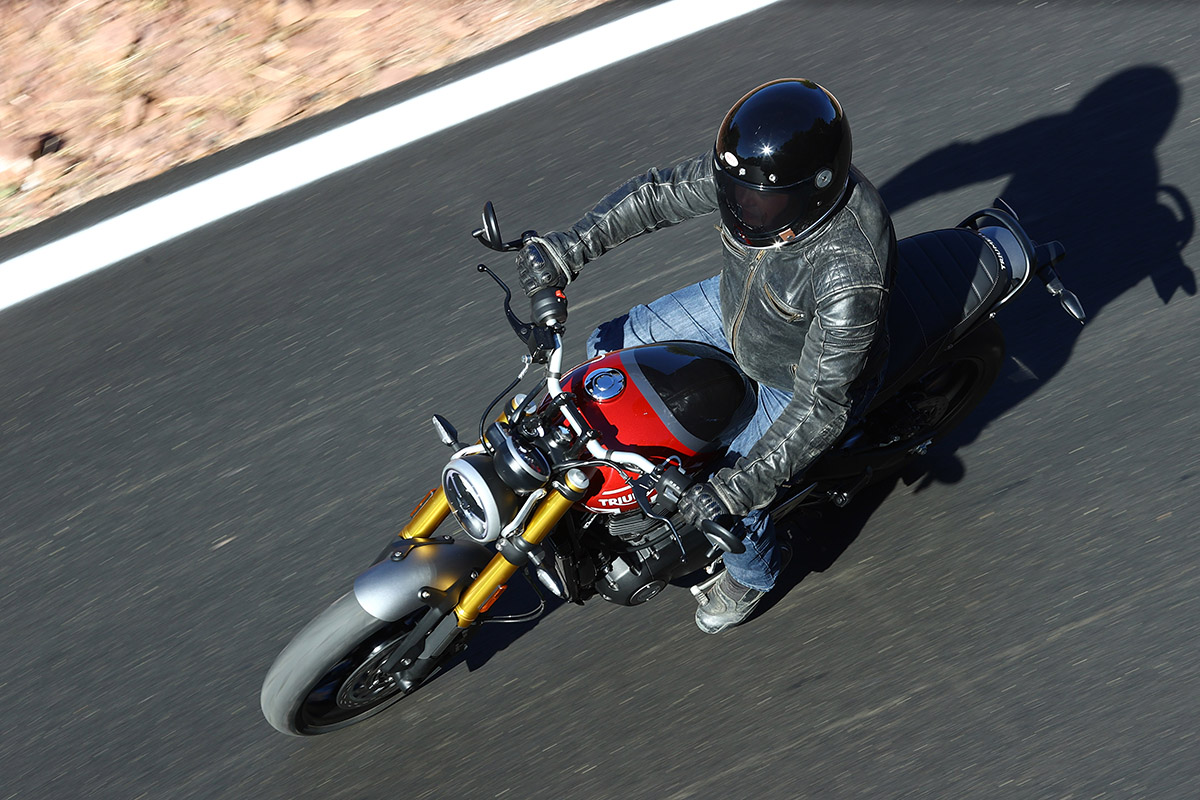
Can the Triumph Speed 400 be modified?
Too right the Triumph Speed 400 can be customised! Triumph have always been active in offering a range of official accessories for its bigger motorcycles, and there are over 25 dedicated add-on parts for the new 400s. These include a neat little flyscreen, heated handlebar grips and a practical top box, meaning riders can adapt the bike to their needs or personal design tastes.
How does the Triumph Speed 400 compare to the Scrambler 400 X?
We’ll have a full review on the Scrambler too, but we were surprised by just how different the two bikes felt when we rode them back-to-back. They share the same engine, but the Scrambler has a different frame, wheels and suspension, as well as wider handlebars and a few other small differences. The Scrambler certainly feels taller and a little less agile, but on the mountain passes the wider bars certainly helped lever the bike through hairpins that bit better. Triumph reckon there will be roughly a 50-50 split when it comes to sales. Personally the greater agility and roadster styling of the Speed 400 would get my dollar but it’s horses for courses really, and taller riders may prefer the roomier ergonomics of the Scrambler.
But is the Triumph Speed 400 any good?
In a word, yes! Simple singles were at the heart of Triumph’s model range during the British motorcycle industry’s golden years in the 1950s and ‘60s. While the Bonnevilles gained all the headlines, it was the basic and affordable Tiger Cubs that got the masses moving.
And so it is with the 2024 Triumph 400s. Looking at the UK specifically, these new machines are likely to prove popular with A2 licence holders, as well as the older riders looking for a simple motorbike that is easy to ride. Royal Enfield have been doing great business in this sector in recent years, and the competitively priced Speed 400 should definitely have them worried.
What I love about the Speed 400 (and the Scrambler 400 X for that matter) is that it seems to have found a real niche in the marketplace. For me, the benchmarks in the A2 class have long been Honda’s 500 range. The Triumph can’t quite match them on performance, but it isn’t far behind and seriously undercuts them on price, despite having a level of componentry which feels a step above the competition. Triumph says that the new 400s offer a ‘new category benchmark for quality, detail and finish’ and while you often have to slice through the marketing hyperbole accompanying new model launches these days, I’m in total agreement with them this time. Only the much more expensive Husqvarna and KTM models really come close to matching the spec and finish, but even then I’d want to inspect them side by side before passing judgement.
It's a handsome motorcycle with more presence than its price tag suggests and the styling is instantly recognisable as a Triumph roadster, taking plenty of design cues from the bigger Speed Twin models, which in turn take their inspiration from the classic Brit bike designs of the 1960s. Personally I doff my cap to the team at Triumph for their new 400s. Any team of talented engineers can develop a 200bhp superbike given enough resources but the challenge of making such a high quality motorcycle, which can be manufactured, distributed and sold profitably for under £5,000 should never be underestimated. The Speed 400 has been designed to do a job and hit a price point. To that end, it hits the brief bang on the bullseye, while remaining stylish and definitely not feeling budget. Frankly I can’t believe it only costs £5,000!
Is the Speed 400 any good? I’d say it’s better than good. It’s a Triumph!
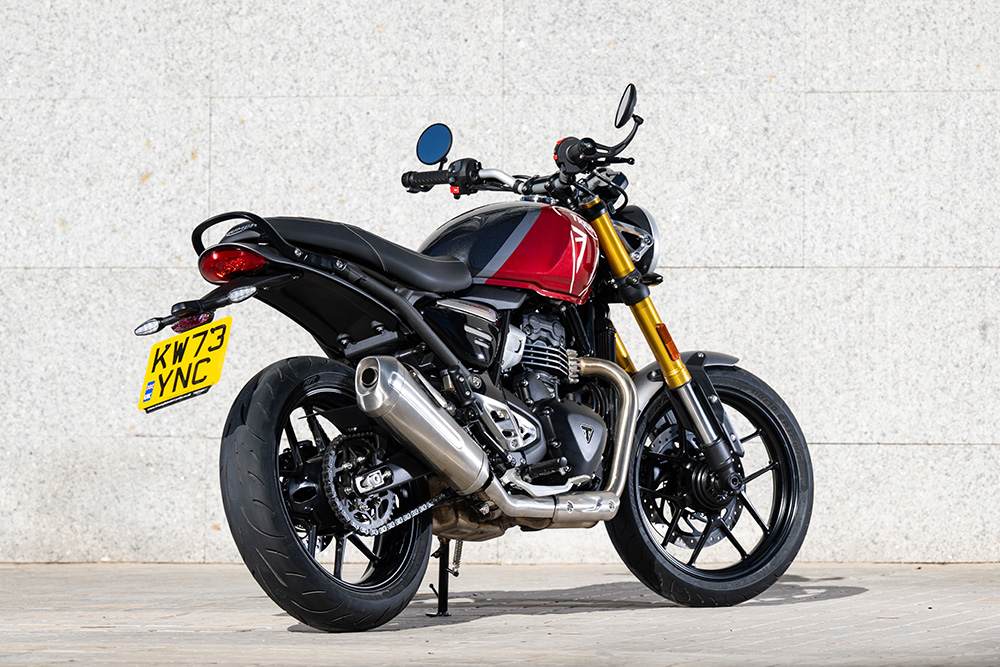
Triumph Speed 400 specification
Price: £4,995
Engine: 398cc, liquid cooled, DOHC, four-valve, single cylinder
Power: 39.5bhp @ 8,000rpm
Torque: 37.5Nm @ 6,500rpm
Suspension: 43mm upside down big piston forks. Single gas monoshock rear with external reservoir and preload adjustment
Wheels: 10 spoke cast aluminium, 17” front and rear
Tyres: Metzeler Sportec M9RR. Front 110/70-17, rear 150/60-17
Weight: 170kg (wet)
Seat height: 790mm
Fuel tank: 13 litres
Contact: www.triumphmotorcycles.co.uk


